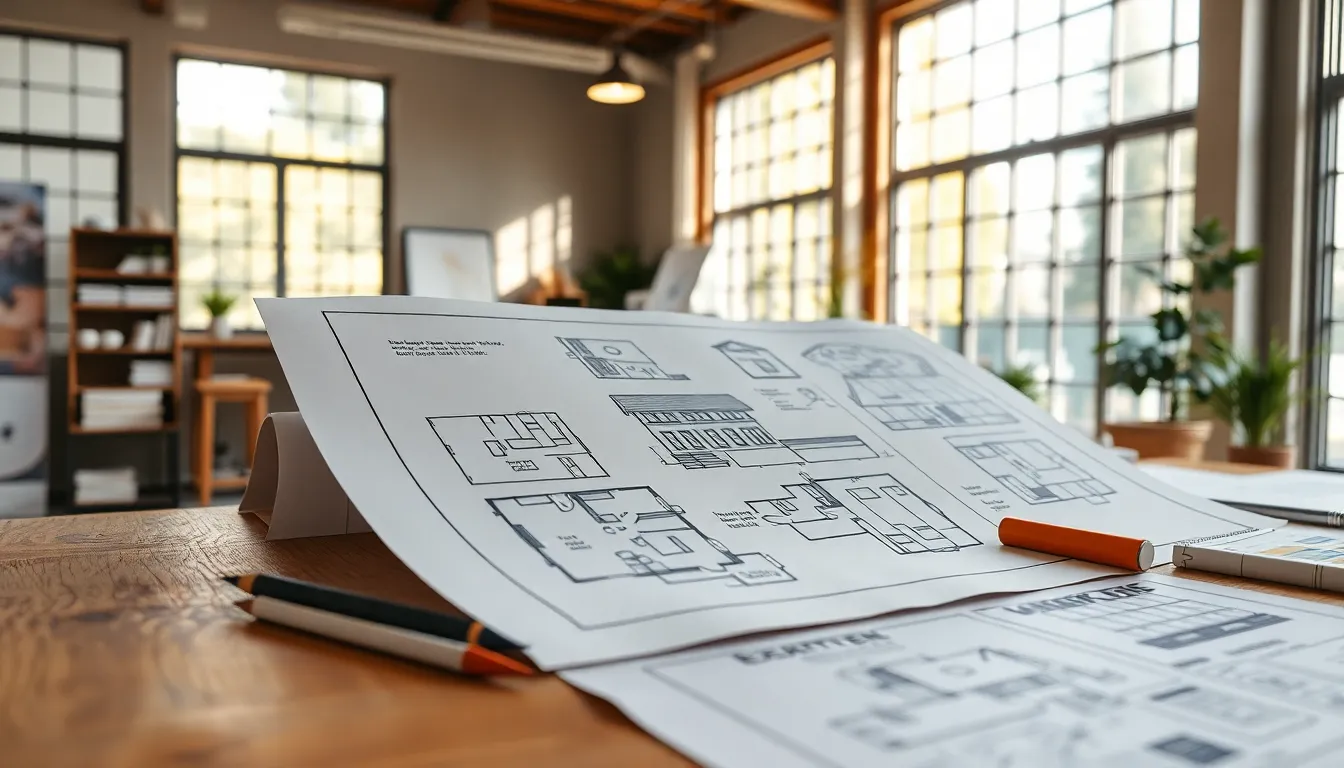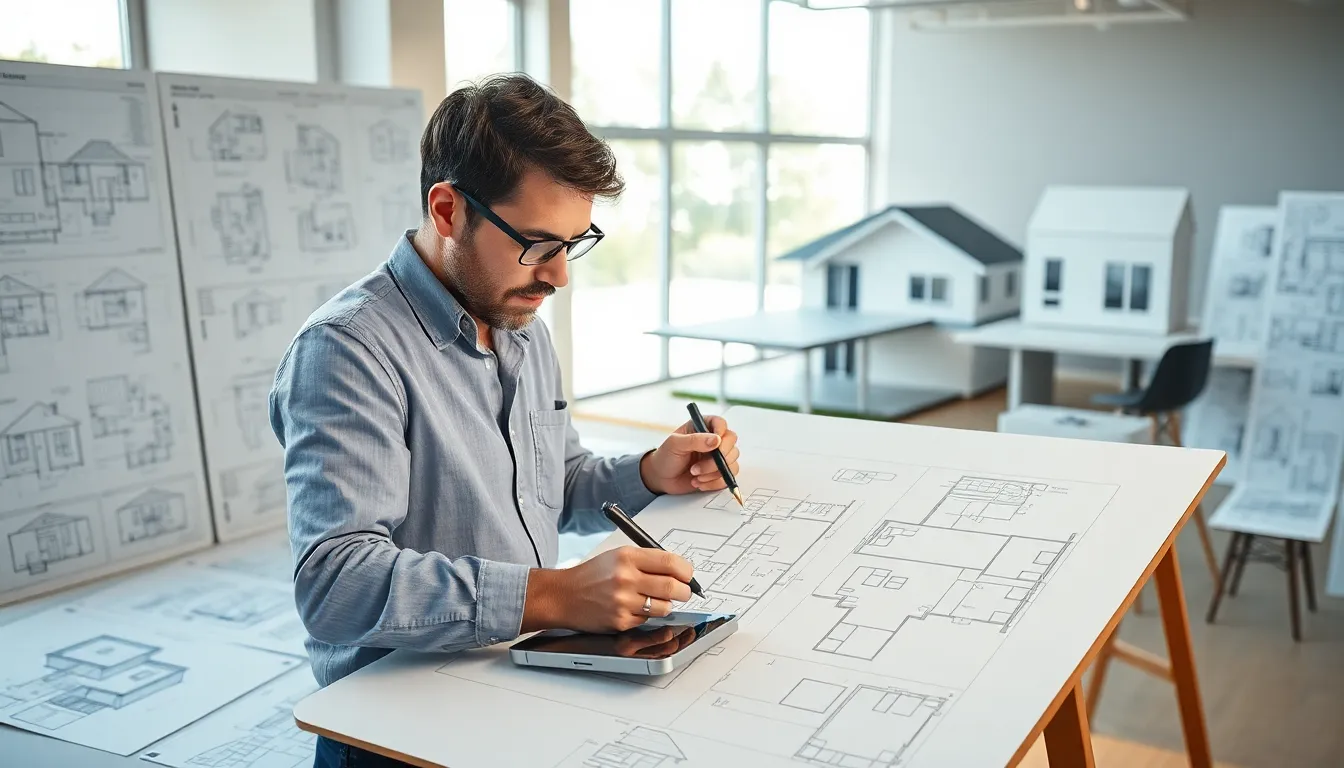When it comes to creating the perfect home, architecture house design drawings are the unsung heroes of the process. They’re not just fancy doodles on a napkin; they’re the blueprints that turn dreams into reality. Imagine a world where your Pinterest boards come to life—complete with that cozy reading nook and a kitchen that would make even Gordon Ramsay smile.
These drawings are the secret sauce behind every stunning abode, blending creativity with precision. Whether it’s a sleek modern masterpiece or a charming cottage, the right design can transform a simple structure into a breathtaking work of art. So grab your sketchpad and let’s dive into the fascinating world of architectural design, where every line tells a story and every room has a personality. Who knew drawing could be this much fun?
Table of Contents
ToggleUnderstanding Architecture House Design Drawing
Architecture house design drawings serve as the backbone for constructing homes. These drawings encompass details that translate creative visions into tangible structures.
Importance of Design Drawings
Design drawings provide essential guidance for construction teams, ensuring accurate interpretations of architectural ideas. They offer clarity regarding spatial relationships and proportions. Homeowners also benefit from these blueprints by visualizing their future spaces, allowing them to make informed decisions. Furthermore, design drawings can help identify potential issues before they arise, saving both time and money during the construction process. This planning phase ensures that each element of the home aligns with the initial vision, enhancing satisfaction with the final result.
Key Elements of Design Drawings
Several key elements contribute to effective design drawings, including floor plans, elevations, and sections. Floor plans detail the layout and function of each room within the home. Elevations depict exterior views, showcasing materials and architectural styles. Sections provide insight into vertical relationships and building heights. Additionally, annotations offer important notes on dimensions and materials, promoting clear communication between clients and builders. Understanding these elements fosters a comprehensive approach to home design, leading to better outcomes during construction.
Types of Architecture House Design Drawings

Architecture house design drawings come in several types, each serving a specific purpose. Understanding these types helps in visualizing and realizing various design concepts.
Conceptual Drawings
Conceptual drawings represent initial design ideas and explore creative possibilities. These drawings prioritize aesthetics and spatial relationships over technical details. Sketches, diagrams, and freehand illustrations fall under this category, capturing the imagination of homeowners and architects. They allow for experimentation with layouts, materials, and forms. Conceptual drawings serve as a foundation for further development, facilitating discussions and evaluations before reaching a final design.
Technical Drawings
Technical drawings provide precise measurements, specifications, and details necessary for construction. These illustrations include essential components like floor plans, elevations, sections, and details, guiding builders through the construction process. Clarity and accuracy are critical aspects of technical drawings, ensuring that construction teams interpret the design correctly. Architects often use software tools to create these drawings, which adhere to industry standards and regulations. Well-executed technical drawings streamline construction, reducing the likelihood of errors and enhancing the overall quality of the built environment.
The Process of Creating Design Drawings
Creating design drawings involves several key steps that transform concepts into construction-ready plans. Each phase contributes to the overall clarity and precision necessary for successful architectural design.
Initial Sketching
Initial sketching serves as the foundational phase of design drawing. Architects begin by brainstorming ideas on paper. Quick, freehand sketches capture thoughts, dimensions, and spatial relationships without constraints. These sketches facilitate creative exploration, offering flexibility to revise and refine concepts rapidly. Feedback from clients often shapes these drafts, ensuring designs align with their vision. This step prioritizes aesthetics, allowing for a holistic view of how the space will feel.
Digital Tools and Software
Digital tools and software revolutionize the design drawing process. Architects utilize programs like AutoCAD, SketchUp, and Revit for precise technical drawings. Such software enhances accuracy, providing scalable models that represent actual dimensions. Its features allow for easy manipulation of designs, facilitating updates based on client feedback or site conditions. Collaborative tools enable real-time sharing with clients and builders, streamlining communication. Employing these digital solutions minimizes errors and optimizes the overall workflow, making the transition from concept to construction more efficient.
Common Mistakes in House Design Drawings
Common mistakes in house design drawings can lead to significant issues during construction. Recognizing these pitfalls enhances the overall design process.
Inaccurate Measurements
Inaccurate measurements often create costly complications. Relying on approximations may result in structural flaws or ill-fitting components. Many architects emphasize the importance of precise dimensions in every drawing. Overlooking small details like door widths or window heights can impact usability. Using digital tools reduces the likelihood of measurement errors, enabling architects to create highly accurate plans. Regular checks and reviews throughout the design process also minimize inaccuracies. Therefore, establishing a habit of double-checking measurements at each phase helps ensure structural integrity and alignment.
Ignoring Building Codes
Ignoring building codes leads to compliance issues and expensive revisions. Each jurisdiction has specific regulations governing construction standards. Failing to account for these codes can halt progress on a project and incur penalties. Architects are responsible for thoroughly researching local requirements before finalizing design drawings. Some common codes include zoning laws, safety regulations, and accessibility standards. Adhering to these regulations not only ensures safety but also enhances the design’s functionality. Involving code consultants during the design phase assures adherence to standards, providing peace of mind.
Architectural house design drawings are the foundation of creating homes that reflect personal style and functionality. These drawings not only bridge the gap between imagination and reality but also ensure that every detail is thoughtfully considered. By utilizing both conceptual and technical drawings, architects can communicate effectively with clients and builders, paving the way for successful projects.
As technology continues to evolve, the tools available for creating these drawings only get better. This enhances the design process and minimizes the risk of errors. Ultimately, embracing the art and precision of architectural drawings leads to homes that are not just built but crafted with care and intention.




